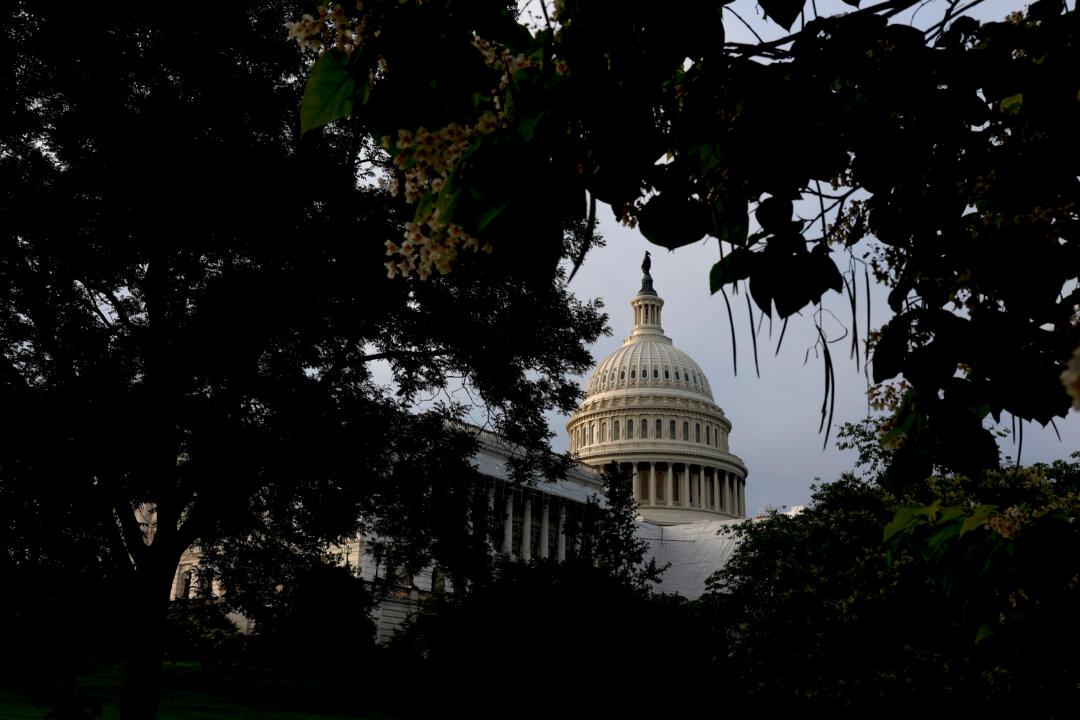It took the better part of the weekend to unravel the truth behind the headlines that President Joe Biden presides over a job-creation machine. Looking at the details beneath the big claims paints a frightening picture not of a growing and enterprising economy but rather the opposite.
What we find is a picture of an increasingly desperate middle class, scrambling to supplement household income to pay the bills.
Are these new jobs? Yes, but what kind of jobs are they?
The Department of Labor reported 528,000 new jobs from June to July. That’s supposed to get us all fired up about how things are going. Tens of millions heard that claim on the day it was made.
But a deep dive into the household survey reveals otherwise. The clue is in the labor participation rates, which are falling, and also the worker/population ratio, which also is falling again. Neither has entered back into an upward trajectory after the devastation of lockdowns.
![(Data: Federal Reserve Economic Data [FRED], St. Louis Fed; Chart: Jeffrey A. Tucker)](/_next/image?url=https%3A%2F%2Fimg.theepochtimes.com%2Fassets%2Fuploads%2F2022%2F08%2F08%2F1-JAT-2022.08.08-1200x937.png&w=1200&q=75)
So here’s a simple riddle to test your economic intuition. How is it that fewer people are working but there are more total jobs? Anyone using their noggin would immediately answer: Either this data is fishy or people are getting second and third jobs, probably to make ends meet and otherwise fix a problem that currently vexes the middle class.
Indeed, that is the correct answer. The Bureau of Labor Statistics reveals that from June to July, fully 250,000 people lost full-time employment while 300,000 picked up part-time jobs. These part-time jobs are increasing following a year of labor chaos, falling real incomes, and rising credit card debt. This suggests a certain level of worry in the population, among those not too demoralized to have dropped out completely, about the standard of living.
This is also the first time since the beginning of lockdowns that full-time employment is falling at the same time that part-time employment is rising.
![(Data: Federal Reserve Economic Data [FRED], St. Louis Fed; Chart: Jeffrey A. Tucker)](/_next/image?url=https%3A%2F%2Fimg.theepochtimes.com%2Fassets%2Fuploads%2F2022%2F08%2F08%2F2-JAT-2022.08.08-1200x994.png&w=1200&q=75)
![(Data: Federal Reserve Economic Data [FRED], St. Louis Fed; Chart: Jeffrey A. Tucker)](/_next/image?url=https%3A%2F%2Fimg.theepochtimes.com%2Fassets%2Fuploads%2F2022%2F08%2F08%2F3-JAT-2022.08.08_web.jpg&w=1200&q=75)
Here, we find something startling. The combination of “part time for economic reasons” plus “part time for noneconomic reasons” rose a total of 804,000 from June to July. That swamps the 528,000 figure that the Biden administration touts by the hour at White House press conferences, where no reporter smart enough has yet questioned the completely bogus implications that this represents economic health.
This is the first time we’ve seen the effects of dramatically falling real personal income. In little over a year of this mess, we’ve seen personal income fall nationwide by $1 trillion once adjusted for inflation. And every day that inflation rages, this gets worse.
The deeper you dig, the worse the situation looks. When Biden took office, there were 233,000 people who already worked two-full time jobs to make ends meet. Today, that number is 433,000—the highest it has ever been. Can you imagine having to work two full-time jobs to make ends meet and then hearing the U.S. president proclaim that it’s because the economy is so strong?
![(Data: Federal Reserve Economic Data [FRED], St. Louis Fed; Chart: Jeffrey A. Tucker)](/_next/image?url=https%3A%2F%2Fimg.theepochtimes.com%2Fassets%2Fuploads%2F2022%2F08%2F08%2F4-JAT-2022.08.08-1200x922.png&w=1200&q=75)
The incredible irony—and this is obvious looking back—is that if we calculate jobs in raw terms, a rise could indicate falling standards of living rather than the reverse. That’s why the only figures we should be looking at are jobs per capita, not number of jobs per se. In addition, labor economists to whom I’ve been speaking are deeply skeptical about these wild adjustments for seasonality to contribute to the headline number that the Biden administration is touting.
The single worst way to judge the health of an economy is in employment numbers. Not only are they extremely complicated and subject to inaccuracies of reporting, but it’s also not at all obvious that maximizing the number of people who get a paycheck for doing something is the means by which societies become rich. It isn’t.
In every society at all times, there is an infinite amount of work to do. The real issue is creating an environment in which fluid production structures work properly so that everyone who wants to contribute productively can do so while earning back to productivity in wages and salaries.
This confusion over employment and unemployment was sewn during the Great Depression, when unemployment became a nationally persistent problem for the first time. That shifted policy priorities toward the creation of jobs for their own sake. President Franklin Roosevelt rolled out a plethora of programs to employ people just for doing stuff that seemed necessary to be done. This practice continued for decades with the idea of keeping the unemployment rate as low as possible.
What’s wrong with this is shown in the weird reality that in the Soviet Union in the old days, the unemployment rate was effectively zero. In fact, it was a criminal offense not to be employed. Work for its own sake was instilled from the earliest ages. That everyone had a job gave decades of bragging rights to Soviet dictators, all while the whole society sank ever further into poverty.
There is nothing about “jobs” as such that signals prosperity. Indeed, we might consider a counterfactual ideal in which riches are so plentiful that working truly does become an option for most. Households do well with one income stream, or perhaps none, as generations of trust-fund kids in the UK and U.S. experienced in the interwar period. Indeed, should we ever again enter on a path toward prosperity again—this is doubtful until we get a renewed policy focus on freedom—we might indeed see an exhausted labor force trade in some work for leisure, causing another shift in the curve.
For example, someday we might like to get back to a time in which an average household can be prosperous with only one income stream. The notion of one-income households became ever more rare after the great inflation of the late 1970s. It’s a legitimate worry that one-income individuals will become a rarity after this new great inflation.
Whether this means doing Uber or DoorDash or table service after work, or giving up weekends to slog away at your side gig or even adding a second full-time job, this is not how prosperity and economic growth are supposed to work. But it is what becomes necessary when real wages and income are falling. Even more alarming are those 1 million Americans who can work, but since March 2022 have decided that it’s simply not worth it and dropped out completely.
![(Data: Federal Reserve Economic Data [FRED], St. Louis Fed; Chart: Jeffrey A. Tucker)](/_next/image?url=https%3A%2F%2Fimg.theepochtimes.com%2Fassets%2Fuploads%2F2022%2F08%2F08%2F5-JAT-2022.08.08-1200x933.png&w=1200&q=75)
We are starting to see all these terrible trends in this new labor report. Rather than celebrate, it should deeply alarm us.
Surely, people are weary of political statements that are designed to gaslight us; that is, trying to convince us of a reality that is the opposite of true. Once one realizes that these pronouncements are designed only for political manipulation and power retention, all else becomes clear.







